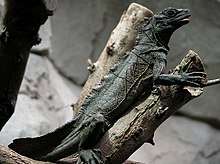Hydrosaurus amboinensis
The Amboina sail-finned lizard or Amboina sailfin lizard (Hydrosaurus amboinensis)[1][2] is the largest agamid lizard in the world, growing to over one metre (3.3 ft) in length. It is found in wooded habitats near water in New Guinea (both Papua New Guinea and Western New Guinea, Indonesia) and Ambon/Amboina Island (Indonesia).[1][3] Although it has been reported from the Philippines[4] and Sulawesi, a genetic study have shown that all in the former country (even southern ones, which have caused confusion in the past[5]) are Philippine sailfin lizards H. pustulatus, while genetic and morphological studies have shown that individuals from the latter island belong to two separate to which the names H. celebensis and H. microlophus are available.[3][6] Adult male Amboina sail-finned lizards have outer edges of the eyes that are medium-dark clear blue and no nose crest, which are some of the features that separate them from the Sulawesi species.[6]
| Hydrosaurus amboinensis | |
|---|---|
 | |
| At Wrocław Zoo (above), and Burgers' Zoo (below) | |
| Scientific classification | |
| Kingdom: | Animalia |
| Phylum: | Chordata |
| Class: | Reptilia |
| Order: | Squamata |
| Suborder: | Iguania |
| Family: | Agamidae |
| Genus: | Hydrosaurus |
| Species: | H. amboinensis |
| Binomial name | |
| Hydrosaurus amboinensis (Schlosser, 1768)[1] | |
Sailfin lizards are semiaquatic and able to run short distances across water using both their feet and tail for support, similar to the basilisks.[7]
References
- Hydrosaurus amboinensis, The Reptile Database
- Zipcode zoo.com
- Cameron D. Siler, Andrés Lira-Noriega, Rafe M. Brown (2014). Conservation genetics of Australasian sailfin lizards: Flagship species threatened by coastal development and insufficient protected area coverage. Biological Conservation 169: 100–108. doi:10.1016/j.biocon.2013.10.014
- Herpwatch.org
- Ledesma, M.; Brown, R.; Sy, E. & Rico, E.L. (2009). "Hydrosaurus pustulatus". The IUCN Red List of Threatened Species. IUCN. 2009: e.T10335A3194587. doi:10.2305/IUCN.UK.2009-2.RLTS.T10335A3194587.en. Retrieved 14 January 2018.
- Denzer, W.; P.D. Campbell; U. Manthey; A. Glässer-Trobisch; A. Koch (2020). "Dragons in Neglect: Taxonomic Revision of the Sulawesi Sailfin Lizards of the Genus Hydrosaurus Kaup, 1828 (Squamata, Agamidae)". Zootaxa. 4747 (2): 275–301. doi:10.11646/zootaxa.4747.2.3.
- Jackman Bauer (2008). Global diversity of lizards in freshwater (Reptilia: Lacertilia). Hydrobiologia. 595 (1): 581–586.
Further reading
- Bleeker, P. (1860). [12. Reptilien van Boni]. Natuurkundl. Tijdschr. Nederl. Indie, Batavia 22: 81-85
- Boulenger, G.A. (1885). Catalogue of the Lizards in the British Museum (Nat. Hist.) I. Geckonidae, Eublepharidae, Uroplatidae, Pygopodidae, Agamidae. London: 450 pp.
- Das, I. (1993). Jour. Sarawak Mus., 44 (65): 128
- De Rooij, N. de (1915). The Reptiles of the Indo-Australian Archipelago. I. Lacertilia, Chelonia, Emydosauria. Leiden (E. J. Brill), xiv + 384 pp.
- Duméril, A. M. C. and G. Bibron. (1837). Erpétologie Générale ou Histoire Naturelle Complete des Reptiles. Vol. 4. Libr. Encyclopédique Roret, Paris, 570 pp.
- Gábris, J. (2003). Zur Haltung von philippinischen Segelechsen (Hydrosaurus pustulatus). Draco 4 (14): 24-33
- Gray, J. E. 1845. Catalogue of the specimens of lizards in the collection of the British Museum. Trustees of die British Museum/Edward Newman, London: xxvii + 289 pp.
- Günther, A. 1873. Notes on some reptiles and batrachians obtained by Dr. Bernhard Meyer in Celebes and the Philippine Islands. Proc. Zool. Soc. London 1873: 165-172
- Manthey, U. & SCHUSTER, N. 1999. Agamen, 2. Aufl. Natur und Tier Verlag (Münster), 120 pp.
- Peters, Wilhem Carl Hartwig 1872. Über einige von Hrn. Dr. A. B. Meyer bei Gorontalo und Auf den Togian-Inseln gesammelte Amphibien. Monatsber. königl. Akad. Wiss. Berlin. 1872 (Juli): 581-585
- Poche, F. 1903. Einige nothwendige Änderungen in der herpetologischen Nomenklatur. Zool. Anz. 26: 698-703
- Schlosser 1768. Epistola ad F. DEJEAN de L. amboin.
- Shaw, G. 1802. General Zoology, or Systematic Natural History. Vol.3, part 2. G. Kearsley, Thomas Davison, London: 313-615
- Werning, H. (2004). Bibliographie der Gattungen Physignathus, Lophognathus und Hydrosaurus. Iguana Rundschreiben 17 (2): 18-31